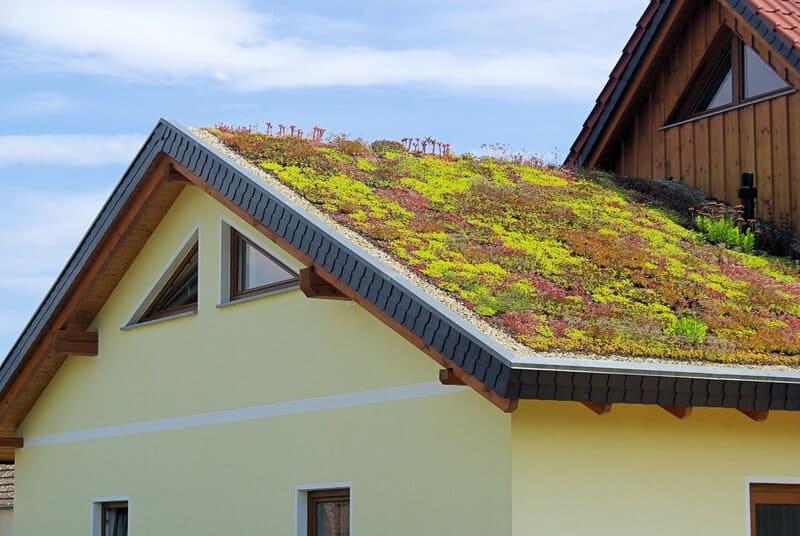-

The term “environmentally friendly” is a very broad one, especially when it comes to roofing materials. For some people, this means materials that are made with little to no toxic materials or adhesives, while others consider a roof that lasts longer and requires less maintenance to be the eco-friendly ticket. Ultimately, Bay Area roofers work to educate and inform our customers about their options, and the decision is up to them.
7 Environmentally Friendly Roofing Products For Bay Area Homes & Businesses
For more detailed information about roofing products on the “Green” spectrum, set up a consultation with a licensed, experienced roofer. For now, here’s our brief “Cheat Sheet” for seven environmentally friendly roofing products.
A Cool Roof System
Materials selection is certainly important. However, the roof plays such a large role in your home’s energy system, particularly in terms of heating and cooling, that we believe cool roofing systems deserve a mention. A cool roof system includes features such as:
- Roofing materials with lighter colors and/or reflective materials to prevent solar heat gain
- Adequate attic insulation
- Proper attic ventilation
Regardless of whether you select eco-friendly roofing materials or not, we strongly advise you to install a cool roofing system that is geared to optimize energy conservation, reduce heating and cooling costs, and optimize the building’s whole-space comfort and indoor air quality.
The Truly Green (aka, “living”) Roof
If you’re looking for a green product that involves completely organic materials and can benefit the environment to boot, you can consider a “living roof.” If you’ve ever been to the California Academy of Sciences, you’ve had the chance to tour one in person.
Living roofs are very specialized roofing designs that require the right level of structural reinforcement for your building because they’re very heavy. The rain-catching and drainage systems are also essential to the structural health of your building.
However, once installed, living green roofs do wonders for the urban heat island effect, help to recycle rainwater and prevent it from running into storm drains, and they act as superb insulation for the building. They also support birds and pollinators in your area.
Just remember that “specialized” is the keyword here. You need a roofing contractor who really understands the ins-and-outs of living roofs, and may need architectural improvements to make it all work with your existing building structure.
Recycled Shingles
After using living materials, one of the highest-rated green roofing materials is recycled shingles. Made to look like wood or more traditional asphalt shingles and are made from 100% recycled materials – including both pre- and post-consumer waste materials.
Like metal roofs (see below), recycled shingles from reputable manufacturers can come with lifespans and warranties up to 40- to 50 years!
Wooden Shingles
We have to give a brief mention of wood shingles, which are certainly eco-friendly in almost every sense of the term. However, with California’s continuing fire traumas year after year, we cannot recommend these in good conscience. They are quick to ignite if wind-blown embers land on them from above, and most homeowners insurance companies will not insure homes with wood shingles anymore.
Synthetic Shake Shingles
Synthetic shake shingles are great news for homeowners who love the look of wood shake shingles, or who are ready to replace their dilapidated versions should consider synthetic shake shingles. Most synthetic shake shingles are made from polyurethane, which is not considered a green material. If you are looking for green from manufacturing to lifetime “start-to-finish,” these may not be right for you.
The shingles look remarkably realistic, deep “wood” grains and all. They are both Class A fire resistant and Class 4 impact resistant. Plus, Bay Area homeowners in wetter or shadier environments appreciate their resistance to mold, mildew, algae, and moss growth.
Slate or clay tiles/shingles
In addition to being made from natural materials (slate is a type of rock, while clay is made using a combination of clay soil and binders), both of these roofing materials are natural insulators. Imagine an adobe house with a clay roof – keeps the heat in during the winter months, while keeping the heat out during peak heat seasons.
Clay tiles made our list of 6 Popular Roofing Materials because we appreciate both its eco-friendly manufacturing and long term lifecycle. They make a great choice here in the Bay Area because they are extremely wind resistant and more impervious to the salt in our coastal air. Like recycled shingles and metal roofs, adequately maintained slate or clay tile/shingle roofs can last for 50 years or longer.
Metal Roofs
Metal roofing is one of the most popular contenders in the environmentally-friendly roofing category. For one thing, metal can be recycled which means once the roof is ready to be replaced, it’s melted and repurposed – no extra landfill waste. Metal roofs are also known for their low-maintenance features, and long warrantied lifespans.
As mentioned above, the lifespan of a metal roof is half a century or so assuming it’s well-maintained. Plus, the ability to apply reflective coatings and direct spray foam insulation make it extra energy efficient. Another bonus for California residents is that metal roofs are one of the most fire-resistant roofing materials on the market.
Are you interested in learning more about environmentally friendly roofing products for your home or business? Schedule a free consultation and estimate with Central Bay Roofing, or call us directly at (510) 521-7334.
Environmentally Friendly Roofing Products
Call Us On (510) 521-7334
Your Local Roofers Since 1978
We invite you to contact us today for an estimate on your roofing project.
1814 Clement Avenue Alameda, CA 94501
(510) 521-7334
info@centralbayroofing.comLicense: 435272 Class B, C-39
Site powered by RooferBoost
Copyright 2017 Central Bay Roofing and Restoration | Login
